Samsung Electronics Co S620 User Manual manual
Samsung Electronics Co Ltd manual
Contents
- 1. manual
- 2. user manual
manual

i User’s Manual
Notice
The information within this manual is subject to change without notice.
The manufacturer shall not be held liable for technical or editorial errors or
omissions contained in herein; nor for incidental or consequential damages
resulting from the furnishing, performance or use of this material.
No part of this publication may be reproduced, stored in a retrieval system, or
transmitted, in any form or by any means, mechanical photocopying, recording or
otherwise, without the prior written permission of the manufacturer.
Product names mentioned herein are for identification purposes only, and may be
trademarks and/or registered trademarks of their respective companies.
1998. All rights reserved

ii
Important Safety Instruction
Read all of these instructions, and save these instructions for later use.
•Follow all warnings and instructions marked on the product.
•Unplug this product from the wall outlet before cleaning. Do not use liquid
cleaners or aerosol cleaners. Use a damp cloth for cleaning.
•Do not use this product near water. Never spill liquid of any kind on the
product.
•Do not place this product on an unstable cart, stand, or table.
•Slots and openings in the cabinet are provided for ventilation. To ensure
reliable operation of the product on a bed, sofa, rug, or other similar
surface. This product should never be placed near or over a radiator or
heat register. This product should not be placed in a built-in installation
unless proper ventilation is provided.
•Before connecting this product to a power source, check the required
voltage and frequency match the available power source.
•This computer is powered by an internal battery pack or by an external AC
power source, Which is supplied with the computer. Use of another
battery pack or AC power source may present risk of fire or explosion. To
disconnect the AC power cord and remove the battery packs.
•This product is equipped with a 2-wire type plug. If you are unable to insert
the plug into the outlet, contact your electrician to replace your obsolete
outlet.
•Do not allow anything to rest on the power cord.
•Do not place this product in a location where someone may trip over the
cord.
•If an extension cord is used with this product, make sure that the total of the
ampere ratings on the products plugged into the extension cord do not
exceed the extension cord ampere rating. Also, make sure that the total of
all products plugged into the wall outlet does not exceed 15 amperes.
•Never push objects of any kind into this product through the cabinet slots,
as they may touch dangerous voltage points or short out parts; that could
result in a risk of fire or electric shock.
•Except as explained elsewhere in this manual, do not attempt to service this
product yourself.
•Handle battery with care. If dropped, they may damaged.
•Do not allow the battery to be exposed to direct sunlight for extended
periods of time.

iii User’s Manual
•Do not attempt to disassemble the battery. If the battery is disassembled and
the electrodes are exposed to outside, the battery may generate eat and
smoke by chemical reaction.
•Do not expose the battery to moisture or chemicals.
•Charge the battery only as described in this document.
•Do not short circuit the battery terminals as the resulting high currents can
damage the battery.
•The battery should not be used to power other products.
•Do not dispose of a used battery in a fire or incinerator, as an explosion may
result.
•The battery should be recycled.
•Do not subject the battery to temperature should not less than -20 degrees
Centigrade or greater than 50 degrees Centigrade.
•Unplug this product from the wall outlet and refer problems to the service
representative under the following conditions:
- When the power cord or plug is damaged or frayed.
- If liquid has been spilled into product.
- If the product has been exposed to rain or water.
- If the product does not operate normally when the operating
instructions are followed, adjust only those controls that are
covered by the operating instructions. Improper adjustment of
other controls may result in damage.
- If the product exhibits a distinct change in performance.

iv
Battery Disposal
Warning : Do not put rechargeable batteries or products powered by non-
removable rechargeable batteries in the garbage.
Contact your customer service representative for information on how to dispose
of batteries that you cannot use or recharge any longer.
Follow all local regulations when old batteries.

v User’s Manual
Federal Communications Commission
(FCC)
This device complies with Part 15 of the FCC Rules. Operation is subject to the
following two conditions:(1) this device may not cause harmful interference, and
(2) this device must accept any interference received, including interference that
may cause undesired operation.
NOTE:
This equipment has been tested and found to comply with the limits for a Class B
digital device pursuant to Part 15 of the FCC Rules. These limits are designed to
provide reasonable protection against harmful interference in a residential
installation. This equipment generate uses and can radiate radio frequency energy
and if not installed and used in accordance with the instructions may cause
harmful interference will not occur in a particular installation. If this equipment
does cause harmful interference to radio or television reception, which can be
determined by turning the equipment off and on, the user is encouraged to try to
correct the interference by one or more of the following measures:
•Reorient or relocate the receiving antenna.
•Increase the separation between the equipment and receiver.
•Connect the equipment into an outlet on a circuit different from that to
which the receiver is connected.
•Consult the dealer or an experienced radio/TV technician for help.
If necessary, the user should consult the dealer or an experienced radio/television
technician for additional suggestions. The user may find the following booklet
helpful: "Something About Interference." This is available at FCC local regional
offices. Our company is not responsible for any radio or television interference
caused by unauthorized modifications of this equipment or the substitution or
attachment of connecting cables and equipment other than those specified by our
company. The correction will be the responsibility of the user. Use only shielded
data cables with this system.

vi
Canadian Radio Interference
Regulations
This apparatus does not exceed the class B limits for radio noise emissions set out
in the radio interference regulations of the Canadian Department of
Communications.
Le présent appareil n’émet pas de bruits radioélectriques dépassant les limites
applicable aux appareils de la classe B prescrites par le règlement de brouillage
radioélectrique dicté par le Ministère des Communictions du Canada.

vii User’s Manual
Table of Contents
Using Your Documentation .............................................................................1
Special Features of the User’s Manual .......................................................1
Using the Software User Documentation ...................................................2
Introducing Your Computer ...........................................................................3
Using Your Computer for the First Time .......................................................5
Installing the Battery ...................................................................................5
Attaching the Power Cord ...........................................................................6
Turning On the Computer ...........................................................................7
Understanding POST ..................................................................................8
Adjusting the LCD Display ........................................................................8
Making Backup Disks .................................................................................8
Turning Off Your Computer .......................................................................9
Restarting Your Computer ..........................................................................9
Tips for Using Your Computer .................................................................10
Traveling with Your Computer .................................................................11
Handling Spills .........................................................................................11
Storing the Computer for Long Periods ....................................................12
Using the Keyboard ........................................................................................13
Using the Numeric Keypad .......................................................................14
Using Special Function Keys ....................................................................15
Using the Touchpad ........................................................................................17
Reading the System Status Lights .................................................................19
Connecting Peripheral Devices ......................................................................21
Using the Floppy Drive ...................................................................................24
Using the CD-ROM Drive ..............................................................................26
Using the Hard Drive ......................................................................................29
Removing the Hard Drive .........................................................................29
Installing a Hard Drive .............................................................................30
Using the Battery ............................................................................................31
Charging the Battery .................................................................................31
Safely Using the Battery ...........................................................................32
Removing the Battery ...............................................................................32
Monitoring the Battery Charge .................................................................33
Using the Battery Gauge .....................................................................33

viii
Battery Warnings ......................................................................................35
Using System Setup .........................................................................................36
Starting System Setup ...............................................................................36
Main Menu ................................................................................................38
Advanced Menu ........................................................................................41
Security Menu ...........................................................................................43
Power Menu ..............................................................................................45
Boot Menu ................................................................................................46
Exit Menu .................................................................................................47
Using System Security ....................................................................................48
Creating a Password ..................................................................................48
Deleting a Password ..................................................................................48
Requiring a Password When the Computer Starts ....................................49
Locking the Hard Drive Boot Sector ........................................................49
Locking the Keyboard ..............................................................................49
Using Power Management Options ...............................................................50
Non-Turbo Mode ......................................................................................50
Standby Mode ...........................................................................................51
Rest Mode .................................................................................................51
Rest Mode Precautions .............................................................................53
Using PowerProfiler .................................................................................53
Creating a Save to Disk Partition ..................................................................55
Windows 95 ..............................................................................................56
Windows NT .............................................................................................57
Changing the Video Configuration ...............................................................59
Resolution and Color Depth .....................................................................59
Selecting a Monitor Type .........................................................................60
Changing Color Depth and Resolution .....................................................61
Working with PC Cards .................................................................................62
Maintaining PC Cards ...............................................................................63
Using PC Cards .........................................................................................63
Windows 95 ........................................................................................64
Windows NT .......................................................................................65
Upgrading Memory ........................................................................................67
Before You Install Memory ................................................................67
Installing a Memory Module ...............................................................68
About Drivers and System Resources ...........................................................71
Drivers ......................................................................................................71

ix User’s Manual
IRQs ..........................................................................................................71
Troubleshooting ..............................................................................................74
Operating Problems ..................................................................................74
Infrared Problems .....................................................................................76
Specifications ...................................................................................................77
Abbreviations ..................................................................................................79
Glossary ...........................................................................................................82
Recording the Computer Hardware Configuration ....................................87
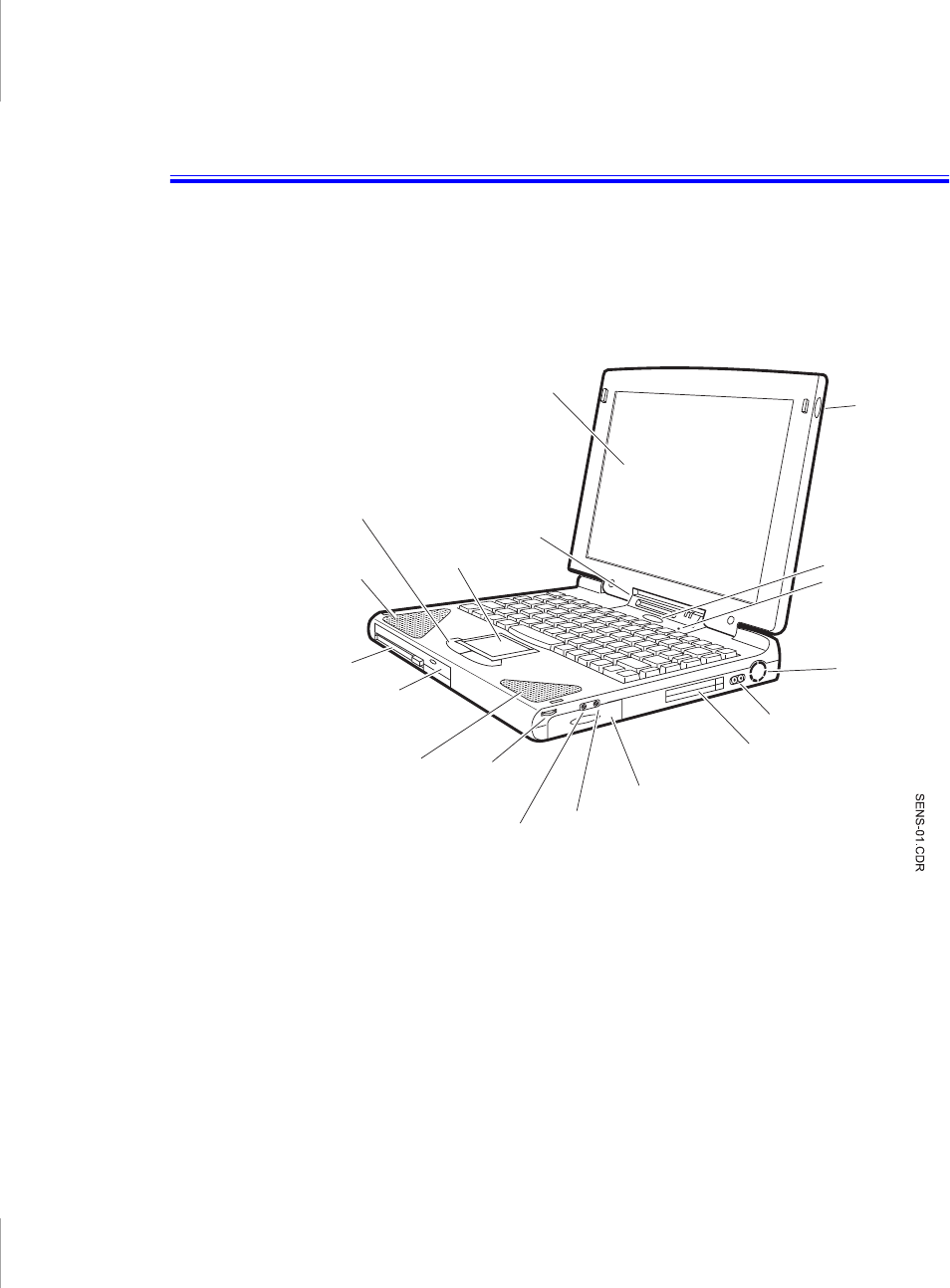
Introducing Your Computer 3
Introducing Your Computer
Your computer is a lightweight portable computer that includes features to meet
your computing needs at home or on the road.
Figures 1 through 3 show you the features of your computer.
Figure 1. Front View of Computer
Cover latch
LCD
Power button
Power cord connector
Fan vent
PC Card compartment
Battery compartment
Headphone jack
Touchpad
Speaker
Speaker
Mouse
buttons Status
lights
Floppy
drive
Microphone
External-mic jack
Volume
control
CD-ROM
drive
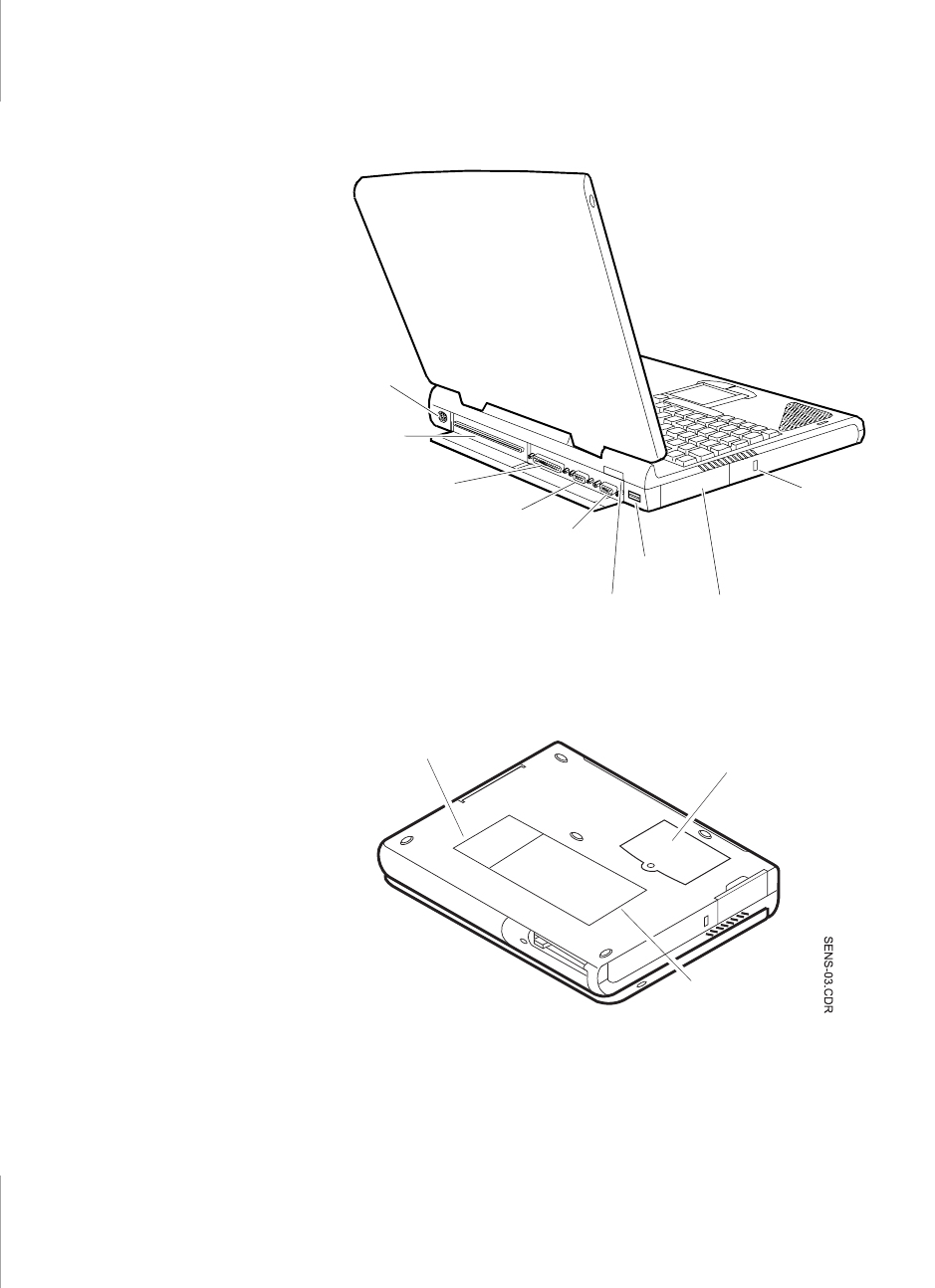
4 User’s Manual
Figure 2. Back View of Computer
Figure 3. Bottom View of Computer
SENS-02.CDR
Infrared
port
Parallel port
Docking
connector
PS/2™
mouse and
keyboard
port
Kensington lock support
Video
port
Serial port
USB port
Hard drive
compartment
Memory module
compartment
Label showing
part number and
serial number
Business card holder
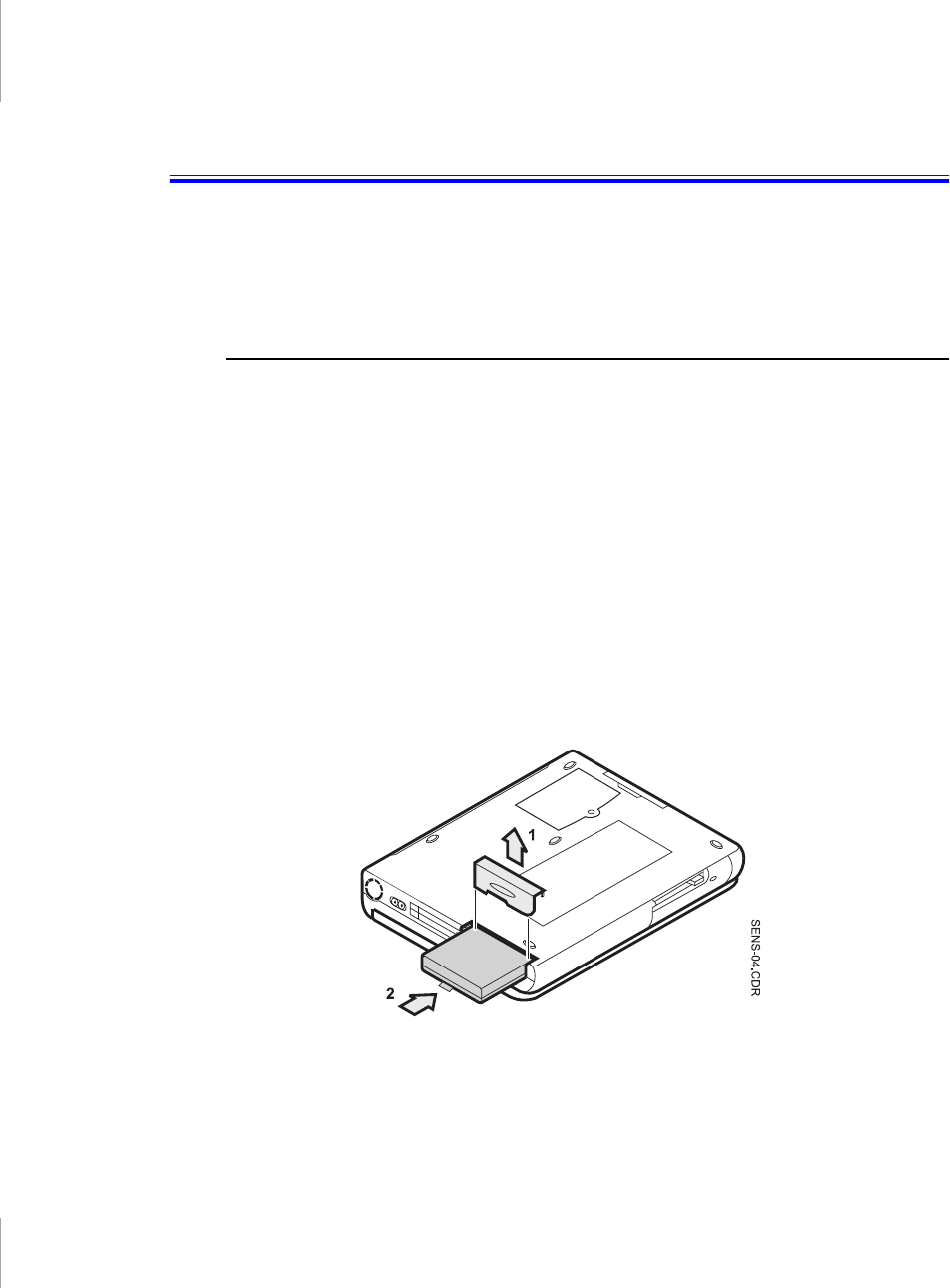
Using Your Computer for the First Time 5
Using Your Computer for the First Time
This section gives you detailed information on using your computer for the first
time.
Installing the Battery
Your computer comes with the battery pack separate from the computer. To install
the battery pack:
1. With the computer’s power off, close the LCD panel and turn the computer
over so the bottom of the unit faces up.
2. Slide the battery compartment cover straight up and off the computer (Figure
4).
3. Slide the battery pack into the compartment. Make sure the battery is fully
inserted into the compartment.
4. Align the tabs on the battery compartment cover with the slots on the battery
compartment.
5. Push the cover straight down until it snaps into place.
Figure 4. Installing the Battery

6 User’s Manual
Attaching the Power Cord
Your computer includes an internal AC adapter that powers the computer and
charges the battery when you plug in the power cord. The first time that you use
your computer, fully charge the battery by attaching the power cord to the
computer and to an electrical outlet.
All batteries lose their charge if they sit unused for an
extended time period. When not used, battery can discharge
fully in 2 to 3 months.
The battery may have discharged in the time it took for the
computer to go from the factory to you.
To attach the power cord:
1. Plug the cord into the power connector on the right side of the computer (Figure
5).
2. Plug the cord into an electrical outlet.
Figure 5. Connecting the Power Cord
The battery starts charging as soon as you plug the power cord into an electrical
outlet. The battery charges faster if the computer is turned off during charging.
Power cord connector
Power cord

Using Your Computer for the First Time 7
If the battery is fully depleted and the computer is turned off, the battery charges
in about 2 hours. If the computer is turned on, the battery charges in about 4 hours.
When the battery is charging, the battery charge light is amber. When the battery
is fully charged, the light turns green.
See ”Using the Battery” for more information on using your computer’s battery.
Turning On the Computer
To turn on the computer’s power for the first time:
1. Press and hold the cover latches on the sides of the cover.
2. Lift up the cover.
3. Press and then release the power button (Figure 6).
The power light is on when the computer’s power is on.
Figure 6. Turning On the Computer’s Power
SENS-06.CDR
Power light
Power button
Cover latches

8 User’s Manual
Understanding POST
When you turn on your computer, a routine called POST (power-on self-test)
automatically runs to test the computer components. Several messages appear on
the screen during POST.
Screen messages are built into the computer to report both normal and abnormal
system conditions. If an error message appears, take any action suggested in the
message. If the message identifies the error condition but does not suggest any
corrective action, write down the message and contact the manufacturer or an
authorized reseller’s service center for assistance.
After POST is completed, a message appears on screen telling you to press any key
to continue. Press a key to finish the start-up procedure.
Adjusting the LCD Display
You may wish to adjust the LCD (liquid-crystal display) when you begin using
your computer. A TFT (thin-film transistor) LCD does not require adjustment for
contrast because the contrast is set to remain at maximum. You can adjust both the
brightness and contrast on a DSTN (double layer super twist nematic) LCD.
To adjust the LCD:
•Press <Fn+Right Arrow> to increase the display brightness.
•Press <Fn+Left Arrow> to decrease the display brightness.
•Press <Fn+Up Arrow> to increase the display contrast.
•Press <Fn+Down Arrow> to decrease the display contrast.
Making Backup Disks
Use the Create System Disks Utility in Windows 95 to make backup disks of any
software on your hard drive. The utility will start automatically when you use your
computer for the first time. You can also open the utility by doing the following:
1. Click the Start button on the taskbar.
2. Select Programs.
3. Select Accessories.

Using Your Computer for the First Time 9
4. Select System Tools.
5. Click Backup.
Turning Off Your Computer
If your computer has a Windows operating system, turn off
your computer by performing the shutdown procedure
described in this section. Otherwise, you may lose data.
To turn off the computer:
1. Click Start on the taskbar.
2. Click Shut Down.
3. Select the shut down option.
4. Click OK or Yes.
•If the operating system is Windows 95, the computer turns off.
•If the operating system is Windows NT, you receive a shutdown message
and must press the power button to turn off the computer.
Restarting Your Computer
You may need to restart (reboot) your computer when installing hardware or
software or if the computer does not respond to your input. A warm (or soft) boot
prompts you to save your files, turns off the computer, and then restarts the
computer. A cold boot turns off the computer without saving your files.
To perform a warm (or soft) boot:
1. Click Start on the taskbar.
2. Click Shut Down.
3. Select the restart option.
4. Click OK or Yes.
5. Save your files if prompted. Your computer reboots.

10 User’s Manual
Do not perform a cold boot unless your keyboard and
touchpad have no effect and you cannot perform a warm
boot.
When you perform a cold boot, you lose data unless it was
saved to a storage medium.
You can also perform a soft boot by saving your files and pressing
<Ctrl+Alt+Del>. You can perform a cold(or hard) boot by pressing the power
button to turn the computer off, waiting five second, and then pressing the power
button to turn the computer on.
Tips for Using Your Computer
The following information helps you avoid potential problems as you use your
computer:
Do not try to disassemble your computer. Opening the
system chassis voids your warranty. Only an authorized
manufacturer’s service center can replace or add any parts
inside the chassis.
•Follow all the instructions and cautions in your computer user documentation.
•The LCD has a polarized surface and can be damaged easily. To prevent
damage, avoid touching the screen.
•Use only memory modules.
•Because a notebook computer is small and has restricted air flow around
components, it is more likely to overheat than a desktop computer. A fan
inside your computer runs when needed to help eliminate some heat. Make
sure the fan vent on the right side of your computer and the air vent on the left
side are not blocked when you use the computer. (See Figure 1 and Figure 2
for the location of the vents.) Occasionally check the vents and remove any
accumulated dust on the outside.
•Avoid using or storing the computer in extremely hot or cold areas, such as a
car on a hot day. Keep the computer away from heaters and out of direct
sunlight. Exposure to excessive heat may damage computer components.

Using Your Computer for the First Time 11
If you have left your computer in a hot place, let it cool down slowly to room
temperature (with the LCD panel open) before using it.
•Do not remove the memory-module compartment door, or try to install a
memory module when the computer is on. (See Figure 3 for the location of the
door.)
(For information on installing memory modules, see “Memory Modules”.)
•Set up your computer work area to avoid physical strain. Sit with your back
straight and supported by your chair. Adjust your chair or work table so that
your arms and wrists can remain in a relaxed position, parallel with the floor.
Avoid bending or twisting your wrists as you work. Your hands should “float”
slightly above the keyboard. Refer to a book on office ergonomics for more
information on setting up your work area.
•Take frequent breaks from working at the computer to rest your eyes and
stretch your muscles.
•Remember to save your data files frequently and to make backup copies of
your files.
Traveling with Your Computer
If you are traveling by airplane, follow these tips:
•Take the computer with you as carry-on luggage. Do not check the computer
with your baggage.
•Allow the computer and disks to go through the
X-ray security devices. Do not hand-carry disks through the walk-through
metal detectors, which can cause loss of data.
•Make sure that the battery is charged or the power cord is easily accessible.
You may be required to turn on the computer for airport security personnel.
•Be prepared to turn off the computer during take off and landing.
Handling Spills
Do not spill anything on your computer. The best way to avoid spills is to avoid
eating and drinking around your computer. If you do spill something on your
computer, turn off your computer, unplug it immediately, and do the following:
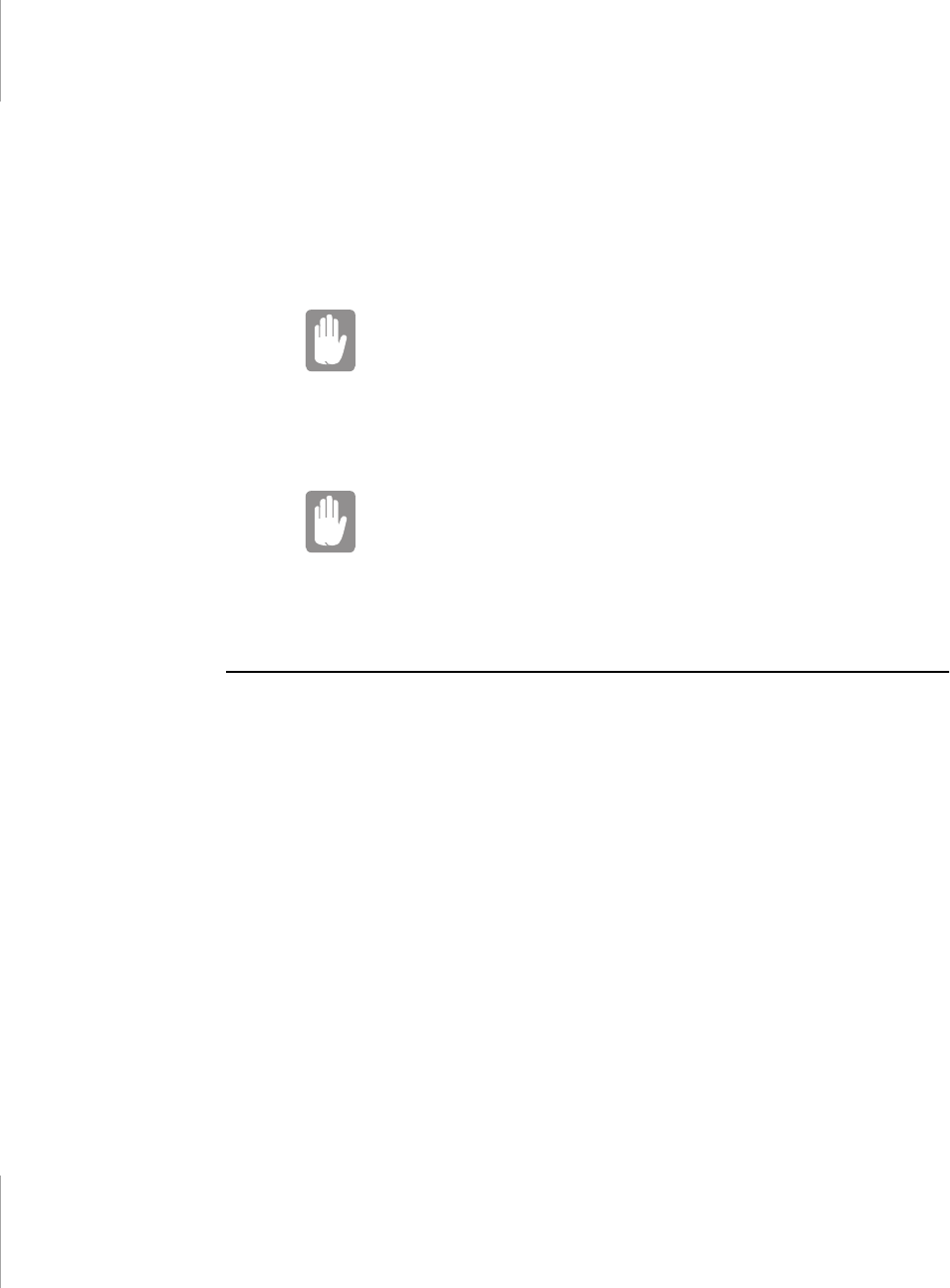
12 User’s Manual
•If you spill liquid on the keyboard, drain as much of the liquid from the
keyboard as possible. Be careful not to let the liquid drip onto the LCD panel.
Allow the system to dry for several days before trying to use it.
•If you spill liquid on an external keyboard or keypad, unplug it and drain as
much of the liquid as possible. Allow the keyboard to sit at room temperature
for a full day before trying to use it.
Sweet liquids leave a sticky residue that may jam the
keyboard despite your efforts to dry it.
•If you spill liquid on the LCD panel, clean it immediately with a soft cloth and
denatured alcohol. Do not use water, window cleaner, acetone, aromatic
solvent, or dry, rough towels to clean it.
Some liquids damage the polarized LCD screen. If your
screen is damaged, contact your authorized manufacturer’s
service center for a replacement.
Storing the Computer for Long Periods
If possible, leave the power cord connected to the computer and an electrical outlet
when the computer is not in use. This helps extend the life of the battery and keeps
the battery fully charged.
If you will not be using the computer for a long period of time (a month or more),
you should charge the battery until it is completely full. After you have done so,
remove the battery from the unit.
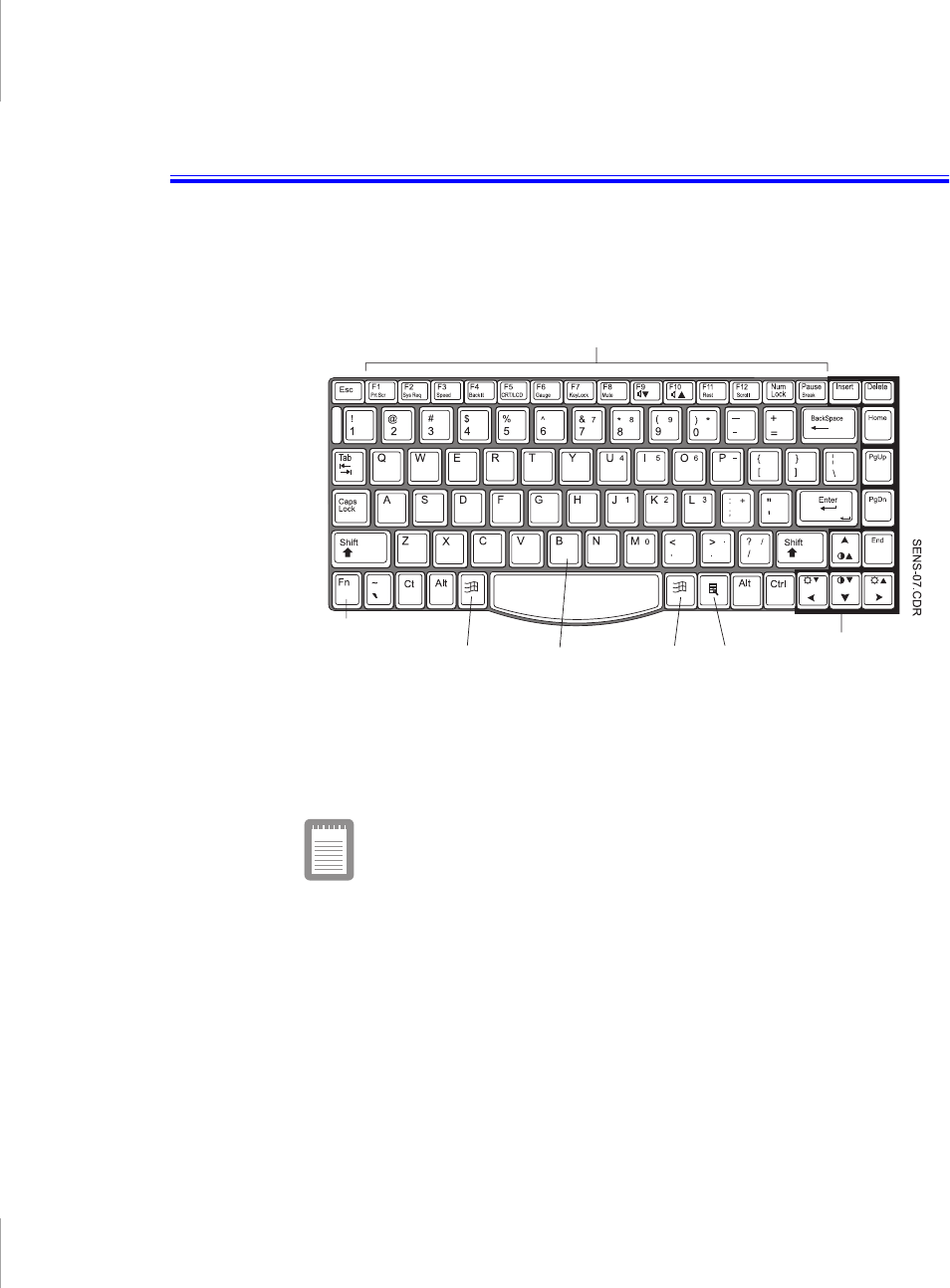
Using the Keyboard 13
Using the Keyboard
Your computer has an 87/88-key keyboard (Figure 7). By pressing designated key
combinations, you can have access to all the key functions of a full-sized keyboard.
Figure 7. Keyboard
Although the layout of the keys on your computer’s keyboard
is different from that on a desktop computer’s keyboard, the
keyboard feels like a full-sized keyboard when you use it. The
distance between the keys (the pitch) is the same as on a full-
size keyboard (19 mm). The travel, or space the key goes
down when pressed, is also the same (3 mm).
Function keys
Windows
key
Cursor-control keys
Typewriter
keys Windows
keys
<Fn> key
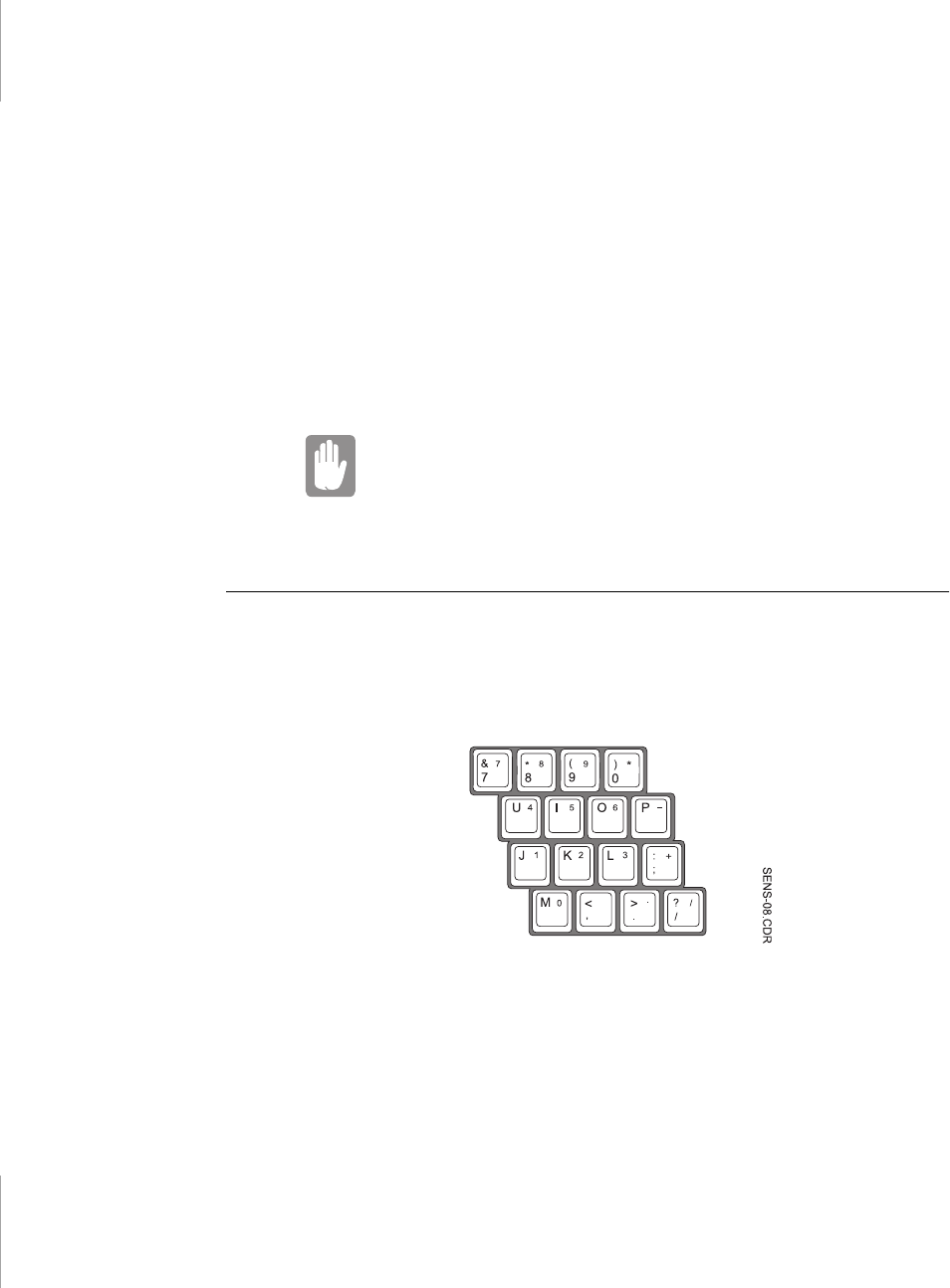
14 User’s Manual
The keys on the keyboard can be grouped into the following categories:
•Full-sized typewriter keys are arranged like a standard typewriter keyboard
and are used for text entry.
•Function keys, when pressed together with the <Fn> key, enable special
functions.
•Cursor control keys move the cursor. They may perform other functions,
depending on your software.
•Windows keys open Windows menus.
To clean the computer keyboard, use slightly damp cotton swabs. Scrub the keys
and the surface around the keys.
Do not allow liquid to drip into the keyboard or you may
damage the keyboard.
Using the Numeric Keypad
Your keyboard includes a numeric keypad, which is a group of keys that you can
set to type numbers and mathematical symbols, such as the plus sign (Figure 8). A
number or symbol on the right corner of each keypad key shows its numeric
function.
Figure 8. Numeric Keypad
Press <Num Lock> to turn on the embedded numeric keypad. The numeric
functions of the keypad are enabled and the Num Lock light turns on. (See Figure
10 for the location of the Num Lock light.)
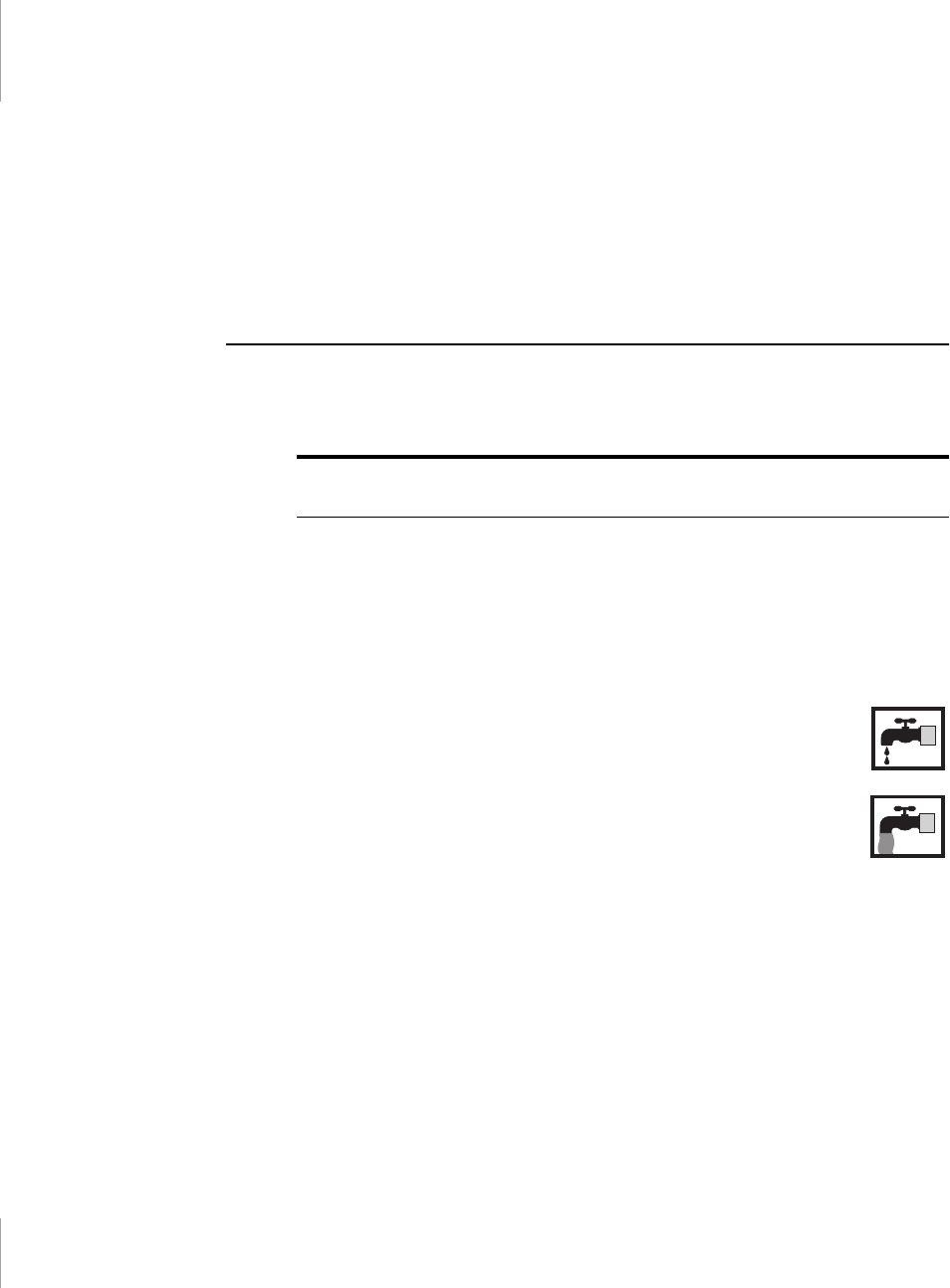
Using the Keyboard 15
While the numeric functions are enabled, you can temporarily return a key to its
normal function by pressing <Fn> and the key. For example to type the letter m,
press <Fn+m>.
To turn the numeric keypad off, press <Num Lock> again. The Num Lock light
turns off.
Using Special Function Keys
The <Fn> key activates special functions when it is pressed in combination with
another key. Table 1 shows the special key combinations.
Table 1. Description of Special Function Keys
<Fn> Key
Combination Function
<Fn+F1>
Print screen:
Takes a picture of the open screen, which you can
paste into the Paint program.
<Fn+F2>
System request:
Reserved for use in software programs.
<Fn+F3>
Speed:
Enables and disables the Power Saving mode. The
options are Turbo and Non-turbo. Press <Fn+F3> to change the
Power Saving mode to their next settings. Press <Fn+F3> again
to return the Power Saving mode to their previous settings.
An icon of a dripping water faucet indicates that Power
Saving mode is Non-turbo mode.
An icon of a water faucet with water running at full force
indicates that Power Saving mode is Turbo mode.
This key combination changes Power Saving modes only until
you turn your computer off and then back on again.
The <Fn+F3> key combination functions only when the computer
is run from the battery. (See ”Power Menu” on page 53 for more
information on power-management settings.)
<Fn+F4>
Backlit
: Turns the LCD display off. Press any key (except the
<Fn> key) to turn the LCD display back on.
<Fn+F5>
CRT/LCD:
Switches the display between the LCD, the external
monitor, and simultaneous display on both the LCD and the
external monitor.

16 User’s Manual
When you press a function key combination, the system
sound may be temporarily muted.
<Fn+F6>
Gauge:
Displays the battery gauge in the upper-right corner of
your screen. To change the Power Saving mode in System Setup,
press <F1> while the gauge is displayed. An icon of a dripping
water faucet indicates that Power Saving mode is Non-turbo
mode. An icon of a water faucet with water running at full force
indicates that Power Saving mode is Turbo mode. <F1> changes
Power Saving mode only when the computer is run from the
battery. The Power Saving mode you choose remains in force
when you turn off the computer.
The gauge closes in a few seconds, or you can press <Esc> to
close the gauge. (See ”Monitoring the Battery Charge” on page
33 for more information on the battery gauge.)
<Fn+F7>
KeyLock:
Locks the keyboard and activates password protection.
Type your password and press <Enter> to unlock the keyboard.
The <Fn+F7> key combination has no effect unless a password is
enabled in System Setup. The Num Lock, Caps Lock, and Scroll
Lock lights blink when the keyboard is locked.
<Fn+F8>
Mute:
Turns the audio output on and off.
<Fn+F9>
Volume down:
Decreases the audio volume.
<Fn+F10>
Volume up:
Increases the audio volume.
<Fn+F11>
Rest:
Puts the computer into rest mode. To resume normal
operation from rest, press the power button. (See ”Using Power
Management Options” on page 50 for more information about the
rest mode.)
<Fn+F12>
Scroll:
In some applications, sets the cursor-control keys to scroll
the page up or down while the cursor position does not change.
Pressing <Fn+F12> again turns off the scrolling function.
<Fn+Up
Arrow>
Contrast up:
Increases the LCD contrast. Contrast adjustment is
not needed on a TFT LCD.
<Fn+Down
Arrow>
Contrast down:
Decreases the LCD contrast. Contrast adjustment
is not needed on a TFT LCD.
<Fn+Right
Arrow>
Brightness up:
Increases the LCD brightness.
<Fn+Left
Arrow>
Brightness down:
Decreases the LCD brightness.

Specifications 77
Specifications
Table 11 gives the specifications for your computer.
Table 11. System Specifications
Dimension
Width 11.9 in (30.8 cm)
Height 2.0 in (5.2 cm)
Depth 10.0 in (25.3 cm)
Weight (with NiMH battery & TFT LCD) 8.13 lb (3687 g)
LCD viewing area (12.1 DSTN) 9.6 x 7.2 in (245.0 x 183.7 mm)
LCD viewing area (12.1 TFT) 9.7 x 7.3 in (246.0 x 184.5 mm)
Environment
Ambient temperature, operating 50o–90o F (10o–32oC)
Ambient temperature, storage 23o–104o F (-5o–40o C)
Relative humidity (noncondensing),
operating
20–80%
Relative humidity (noncondensing),
storage
5–90%
Altitude, operating 0 to 8,000 ft (0 to 2,348 m)
Altitude, storage 0 to 40,000 ft (0 to 12,192 m)
Shock, operating 10 G for 11 ms half sine
Shock, nonoperating 60 G for 11 ms half sine
Nickel-Metal Hydride Battery
Weight 1.33 lb (607 g)
Nominal open circuit voltage 12.0 VCC
Capacity, typical 3500 mAhr, 42whr
Charging time, approximate, with
computer turned off
2 hr
Charging time, approximate, with
computer turned on
4 hr
Average battery life, with no power
management enabled
2 hr